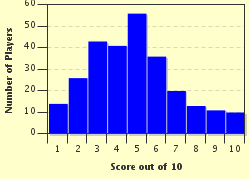Quiz Answer Key and Fun Facts
1. The 1960s were a time of immense change, often referred to as a social revolution. Which of the following counter cultural organizations did NOT start in the 60s?
2. The notable upheaval of the 1860s in America was the Civil War. In all, eleven states seceded from the Union, some before Lincoln's election and some after. What date did Kentucky secede from the Union?
3. By the 1763, Britain had greatly expanded its territory, especially in North America and India. In order to pay for defense of the American colonies in the Seven Years' War, what did the Crown begin to tax without the representation of the colonists - a key cause of the American Revolution?
4. The Great Fire of London was a major conflagration that swept through the central parts of London, England, from Sunday, September 2 to Wednesday September 5, 1666. The aftermath of the fire was unprecedented social upheaval and backlash for the failed leadership of Lord Mayor Sir Thomas Bloodworth. Where did the London fire begin?
5. The 1560s saw a rebellion of Calvinists against Spanish Roman Catholic rule in Flanders. Triggered by the bad harvest of 1565, and economic difficulties due to ongoing wars, protesters in August 1566 stormed the church of Hondschoote to do what?
6. The 1460s saw the middle of a dispute between the Lancastrians and the Yorkists known as the War of the Roses. Which of the following battles was NOT a 1460s battle?
7. Owain Lawgoch was a soldier who served Spain, France, Alsace and Switzerland. In 1369, hostilities resumed between England and France due to the end of the Treaty of Brétigny. Owain seized the opportunity to establish himself as the monarch of his homeland. What land did Owain seek to reclaim?
8. In the 1260s, Gilbert de Clare and Simon de Montfort led massacres of the Jews in Canterbury and Leicester as a wave of antisemitism swept England during yet another time of political unrest. What was considered to be the justification of such massacres at the time?
9. In 1166, the Crusades were fully underway, creating havoc back home in England. Landowners were away from their estates for years at a time. Unoccupied and unclaimed land invited squatters, and since there was no central registry of deeds at the time, disputes were common when aristocrats returned home or died thousands of miles from home. A new concept of law was introduced by Henry II to calm the storms back home. What was the name given to this initiative?
10. The Bayeux Tapestry records the Norman conquest of 1066 and the Battle of Hastings between William the Conqueror and Harold II. What other significant event is also recorded in the tapestry?
Source: Author
sidnobls
This quiz was reviewed by FunTrivia editor
bloomsby before going online.
Any errors found in FunTrivia content are routinely corrected through our feedback system.


